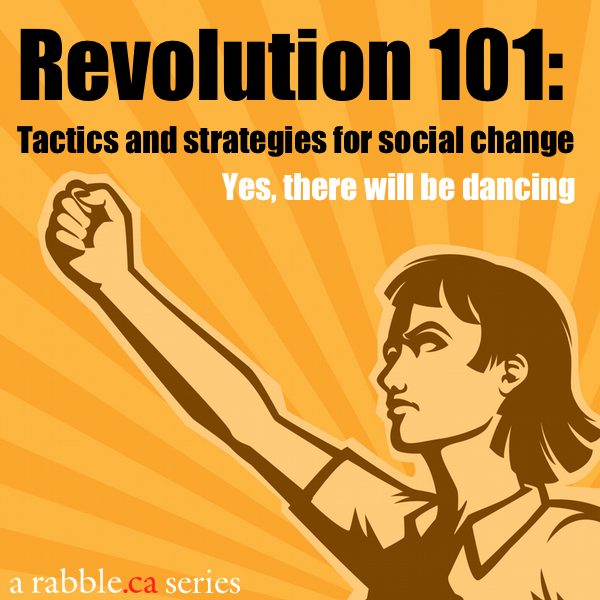The Idle No Movement has created such an amazing, creative, and hopeful movement. Unfortunately as with Occupy, it has not been given such a great name. But when has that ever stopped a movement?
The big issue at stake here is the concept that Indigenous communities have been bored, ineffective and thus idle for 600 years. Some Indigenous and legal scholars claim the “Idle” part to be a reflection of how mainstream societies saw Indigenous Canadians as dirty, lazy, and having no pride left in their bones to defend themselves. But it could just be that academics in America are devoid of Indigenous guidance.
The four founders of Idle No More — activists Nina Wilson, Sheelah Mclean, Sylvia McAdam, and Jessica Gordon — claim they started the movement when in November 2012, during a teach-in at Station 20 West in Saskatoon called “Idle No More,” they rallied opposition to Harper government‘s introduction of Bill C-45.
Other founding members include people like Grand Chief Shawn Atleo, and Chief Theresa Spence who famously started a hunger strike in a tipi in Ottawa demanding a meeting with multiple levels of government.
If I do anything else in these 1,000 words, I’d like to prove to you that Indigenous communities across Turtle Island have not been idle — they have been resisting colonialism since the first European boats washed up all desperate and hungry on North and South American shores.
Prime Minister Stephen Harper was taking a heavy hand to issues relating to Indigenous Canadians, and a number of these measures drew fire from environmental and First Nations groups including an overhaul of the Navigable Waters Protection Act (NWPA) of 1882 in Bill C-45, which renamed it the Navigation Protection Act (NPA).
Another sticking point was how much control the Harper government falsely expected to get regarding any changes to the First Nations Education Act. I could say the same about former AFN National Chief, Shawn Atleo.
Idle No More was powered in its early days by these four strong women who rose up against the Harper government, as of course it would be women who made up a large proportion of the wisdom-keepers (unlike Harper’s army of men) and decision-making elders in a great number of First Nations, Metis and Inuit communities.
There is a special saying — to never let the National Chief leadership or the leadership of the Assembly of First Nations fool you into believing that both men and woman have sacred roles and have to work in harmony, and for the sake of Mother Earth believe us.
Now Idle No More is nipping at the heels of their mainstream leaders such as the former Assembly of First Nations National Chief, Shawn Atleo. The weight of the accusation that he worked too closely with Prime Minister Harper is what eventually forced Atleo to resign.
Idle No More has strategically taken a stand on historically important issues. October 7, 2013 was proclaimed a day of Indigenous Awareness, and on that day, two important things happened. First, the United Nations Special Rapporteur on the Rights of Indigenous Peoples, Professor James Anaya, began his official visit to Canada to examine the human rights situation of Indigenous peoples.
Second, October 7 is the 250th anniversary of the Royal Proclamation of 1763. Through that proclamation, the British Crown recognized Indigenous sovereignty and land title though most of Canada, excluding most of British Columbia.
The main purpose of the proclamation was to create a system of organization to instill and enforce Great Britain’s power in its new North American empire and eventually codify — through treaty — its relationships with Canadian First Nations communities through trade and land agreements.
Idle No More is a movement that is constantly respecting the future by respecting the past. There were certain topics in the past which are still being debated today — including the need for road or rail blockades or occupations. Again, let me remind you that this fight for Indigenous rights just didn’t start on the first day of Idle No More.
What I also like about Idle No More is its intimate knowledge of history as a motivator to move forward; sometimes that motivation was filled with historical hate, and other times with historic hope.
While the issue of blockades has occurred a few time in recent months, all under the command of Idle No More and various sub-groups, it is understood within the movement that blockades are important and have been used in the past for successful resolution of issues.
Here is a small list of direct action locations across Turtle Island.
OKA/Kanesatake (Ontario-Quebec 1999)
Lubicon Cree (Alberta 1988)
Peigan LoneFighters Society (Alberta 1991)
Revenu Rez Occupaton (Toronto 1994-1995)
Sun Peaks (British Columbia 200 –)
And in this case, to quote from OCAP, “Direct Action Gets the Goods.”
I’m not really sure what’s to come. There will still be regional divides, scraps over power and over executive name and title. But to make the decisions facing them, Indigenous peoples need to have a stake in what’s coming next, especially now that the Aboriginal Ministry doesn’t seem to open to community criticism.
But a creative, hopeful future — filled with the contribution of both Indigenous support and allied support will help us to win the fight.
Krystalline Kraus is an intrepid journalist and veteran reporter for rabble.ca since its 2001 beginnings. She needs neither a red cape nor safety goggles to fly into her latest political assignment. She often live-tweets from events — almost exclusively First Nations and environmental issues. You can follow her on Twitter @krystalline_k.



